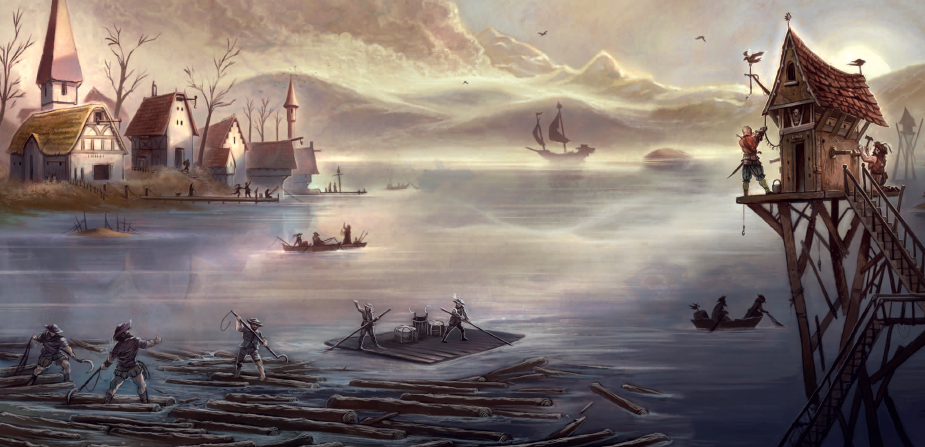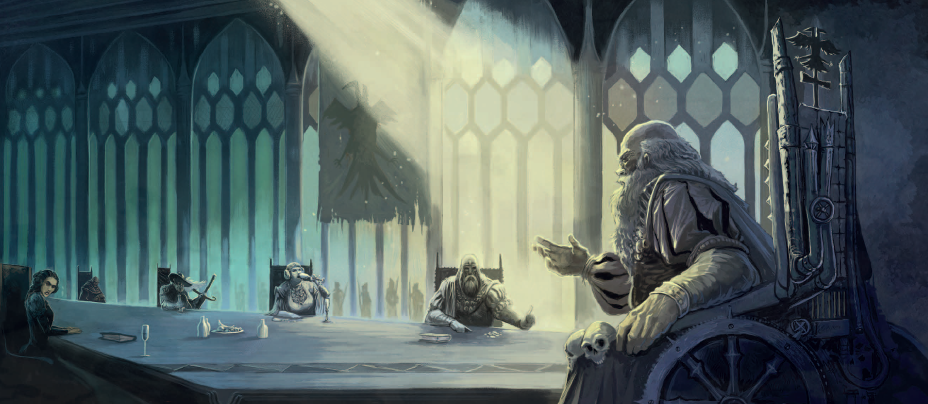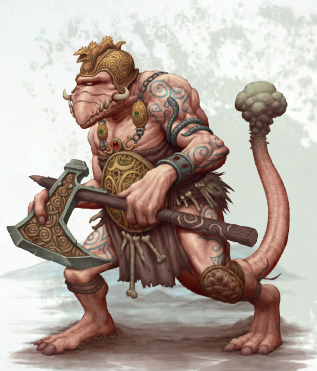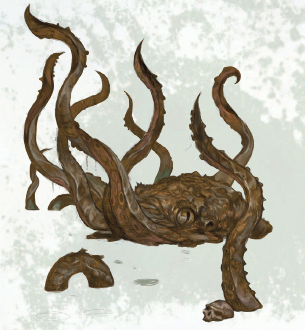My epic review of the WFRP Corebook reaches its conclusion. Part 1 covered the basic system, skills and combat (as well as my disclaimers on what to expect from the review), Part 2 covered careers and advancement and Part 3 covered religion and magic. This final post covers additional systems like corruption and downtime as well as the bestiary.
Corruption
I really like the Corruption system. First and Second Edition featured Insanity Points, but for the first time1 we have something baked into the core rules where PCs can gain mutations as well a mental problems. Every time you encounter something corrupting (warpstone, followers of Chaos, dark magic etc) you test either Endurance (T-based) or Cool (WP-based) and gain one or more corruption points. Then when your corruption points exceed your TB + WPB, you have to test or gain either a physical or mental mutation. (Everyone has the same chance of mutation in general, but non-humans have a significantly lower chance of getting a physical mutation, with no chance at all for Elves.) Finally, Halflings stand to get a substantial benefit from their Resistance to Chaos talent!
The mutations themselves are a little less inspiring – both physical and mental charts have 20 entries, but they’re only a title plus some stat adjustment, so there’s little detail about how to roleplay (say) a Thrill Hunter or an Errant Fantasist. Still, the titles themselves are very evocative. It is a bit disappointing that these replace the much more detailed insanities of previous editions – though I can see that those could be regarded as very insensitive to people living with real mental illness.

Fascinatingly, among the events listed as corrupting are “giving in to despair, rage, excess or the need to change your lot”. I feel like this has the potential to be a little over-used (who doesn’t want to change their lot in life?) but it’s certainly a neat link with the classic Chaos Powers.
Oh and you can choose to gain a Corruption Point in return for a free re-roll – a really nice mechanic for tempting players!
Downtime system
The downtime system is completely new and absolutely fascinating. It is intended to simulate what PCs are doing when they’re not on adventure, without the need for detailed narration on behalf of either the players or GM. First, each player rolls on a table of random events (which reminds of nothing so much as the one in Advanced Heroquest, a lovely throwback to my youth!) This can result in some money being stolen, or certain goods being cheaper, or an acquaintance dying, or dozens of other results. Then you choose an endeavour to do (see below) – and you can do one for every week, up to a maximum of three. Once you’ve done the endeavours, you controversially lose all your money unless you banked it, or earned it from the endeavour – which represents costs of living and frittering away money in whatever way you choose to describe it (booze, gambling, companionship etc).
Endeavours include income (which means you spend the time earning from your current career), banking (save your money – either in a reputable institution, or by sticking it in a hole in the ground), finding a new contact (for information or training), crafting (which sounds complicated!), commissioning an item, or training a skill outside your career (which costs both XP and money) or trying to learn a talent outside your career (which costs XP and money and may fail, wasting both). Then there are class-related endeavours, which generally provide a temporary bonus – a warrior can train and gain limited combat re-rolls, a rogue can case a joint and gain bonuses there, an academic can temporarily gain standing etc.
I think the system is admirable in many respects. You could dispense with it all and handle everything through roleplaying (something the rulebook explicitly mentions), but I think many groups would probably prefer to spend most of their time on adventures and gloss over what happens in between them, which is what this system does. I like that it means there is now explicit support for the idea that PCs’ careers are what they do when they’re not adventuring. 4th Edition really leans into this explanation of the career system, and I like that the rules support it2. The random events feel appropriately Warhammer-y (although I think any longstanding games will need to expand the table to keep from having too much repetition). The endeavours generally feel like they give you a substantial amount of meaningful choice – although I find it really odd that none of them actually represents training the skills in your current career! One thing I really like is that if you’re in tier 3 or 4 of your career, you have to do an Income endeavour – if you don’t, then you actually get downgraded! Its a good representation of the idea that you have responsibilities in the world. There’s also a rule that Elves have to spend one of their endeavours reconnecting with their kin, which is a little balancing thing for the fact that Elves are otherwise basically amazingly 🙂

However, I do feel the system is too abstract in some ways. I’m fine with abstracting training, earning income, or finding a tutor. Yet it seems very odd that there’s a cap on the number of endeavours you can do. By these rules, you could do three endeavours in three weeks – or three in 9 months! If you commission an item it’ll be ready after the next adventure – whether that’s a week away or 6 months away. And however much money you have, if you don’t bank it, you lose every penny. Given how much WFRP’s rules generally strive to simulate (detailed critical hit tables, dozens of skills, a vast plethora of careers) it seems very odd that some of the downtime rules are so abstracted from reality.
It also feels odd that – unless I’ve missed something – there’s no cost of living either. If you end an adventure with two pennies to your name, there’s nothing to stop you spending the next 6 weeks training.
I think the banking system is probably intended to give the PCs a reason to keep adventuring. And there is some realism – its believable that the more money you have, the more you spend on little luxuries. After all it’s easy to imagine that only the players most dedicated to roleplaying will spend money on fripperies that provide no mechanical benefit, so a system the represents the tendency of people to fritter away money they’ve got on drink or nice food has something to recommend it.
I think the downtime system has the makings of a great system. A few changes could make it really good: change banking so it provides a boon (earn interest, save your money being stolen) rather than avoids a default negative; make the timescale more concrete (e.g. one random event per month; one endeavour every fortnight); and provide a cost of living (e.g. the character’s social level income per week). You could even do something clever with scaling up the cost of living depending on the PCs wealth, so characters sitting on a treasure horde will end up spending more of it on fast living!
The Glorious Reikland
Possibly my favourite chapter of the book, this gives tons of detail on the greatest of the Grand Provinces of the Empire. There’s an overview of the environment, covering such classic WFRP locales as sinister forests, mighty rivers and cursed marshes. We get some super detail about Imperial Politics, including the Reikland Council (with lovely descriptions of the great and the good who sit on) and a sample Reikland Estate, which is absolutely fantastic (I’d gladly buy a book full of these). Then there’s a large selection of settlements and fortresses, each of which gets a few paragraphs of detail – enough to really convey what makes them unique. Scattered throughout are adventure hooks, beginning the incredibly Cubicle 7 tendency to just chuck out fun and interesting adventure ideas like sweets.

What we don’t get is an overall description of the Warhammer World or the Old World, which I feel is a bit of a big omission. Hell, even the Empire itself is only detailed in the initial scene-setting introduction to the book: I don’t think it even contains a list of Grand Provinces3! I appreciate the decision Cubicle 7 made to focus in on the Reikland – I like highly-detailed RPG settings, and the Reikland is big enough to comfortably set multiple campaigns in. But even a couple of pages covering the Old World and the Empire overall would have been helpful to set the stage.
Equipment
Weapons and armour are largely in keeping with the 2nd edition rules. Weapons belong to different groups and you need advances in the appropriate skill to use them effectively. Interestingly melee weapons can be used with your base WS, but you don’t benefit from any beneficial qualities of the weapon if you do; this means the humble Hand Weapon (with no special qualities) can actually be used perfectly well by characters without Melee (Basic). Ranged weapons meanwhile can only be used if you have skill, apart from Crossbows which anyone can use. Reloading is now an Extended BS Test with a target number of SLs based on the weapon, so you could conceivable fumble your crossbow reload and take round after round trying to reload! I think this feels reasonably decent in a stressful combat situation.
Shields are still counted as weapons, with special qualities meaning they add a certain amount of armour to all areas (1, 2 or 3 depending on size of shield) and also get bonuses for opposing a Melee Test.

Armour can be layered and metal armour gives penalty to Agility and stealth. There are also some neat special rules, such as plate armour’s Impenetrable (ignore criticals on odd doubles) and Weakpoints (criticals from Impale weapons ignore the armour altogether). There’s also the controversial rule that armour can be sacrificed to prevent a Critical Hit on the appropriate area. Since this is automatic, it does feel a bit too powerful – it basically means that armour becomes incredibly valuable which I don’t think is a good idea.
Bestiary and Traits
The rulebook contains a short bestiary laying out various classic Warhammer monsters (Greenskins, Undead, Daemons, Monsters etc) as well as typical Humans and non-Humans. It’s a very nice selection including normal and monstrous Beasts (including the venerable Fimir and the fabulously horrible Bog Octopus, I’m delighted to say), Greenskins, Undead and minions of Chaos (including the Skaven, naturally).


NPC profiles are now marvellously simplified. Along with the basic profile (which now fits on just one line) they’ll have a small number of skills (presumably just things they will most likely use in an encounter with PCs) plus a handful of traits. Traits include Weapon +x, which shows the amount of damage they add in combat (including their SB, so you don’t have to calculate that) as well as traditional talent-like things such as Fearsome (cause fear) or Painless (ignore debilitating negative penalties to stats caused by critical wounds) or Magical (attacks count as magical). The effect is that you end up NPC profiles taking 4 or 5 lines, in contrast to well over 10 lines in 2nd edition. I love this – it is much more economical in terms of space AND allows writers to more easily convey an NPCs’ character since important skills or talents will stand out much more.
Another element I really like is that certain traits can convey a species’ personality very economically. For instance wild animals tend to have Bestial, which means they usually retreat when reduced to half Wounds, and run from fire. Goblins literally Fear Elves, as well as being infested with flies. Basic Skaven are Skittish, which means they tend to run away when confronted with fire or magic.
The flip side of this, however, is that you need to cross-reference every monster profile with the list of standard traits to find out what (for instance) Bestial actually does. Sure, you’ll eventually learn that, but it is a pain – and its compounded in cases where you also need to look in a different place in the rulebook for descriptions of a creature’s Talents!
The other downside – which has been much-discussed subsequently – is that the creatures detailed here are baseline creatures, which generally will not provide a challenge to even starting Player Characters. Cubicle 7 has done its best to make this clear in blog posts (see e.g. here), and to be fair the rulebook does offer various Generic Traits to easily buff up monsters. But its certainly the case that a GM in the hurry can’t really just grab a profile from the Rulebook and expect it to work out-of-the-box.
Overall Conclusions
There is a LOT to like about WFRP 4th Edition. It’s well-written and bursting with character and has captured the 1st Edition feel very well. The artwork is consistently fantastic (I think it looks better than any other RPG I’ve read) and there’s plenty of it; and there are loads of terrible puns and references to 1st edition adventures, which I appreciate!
I think both the descriptions and the rules do a great job of capturing the Warhammer feel. As in previous editions, careers give a sense of the PCs’ place in the world, but in addition, there are now the social level and downtime systems which reinforce that really well. You really get a sense of the Empire as being a society with classes, where Nobles get privileges far beyond commoners. The combat system is even more deadly than previous editions, with critical hits always a possibility, meaning PCs should always try to avoid it if possible. At the same time its a very complex system which I have concerns about the playability of in practice without using a Virtual TableTop to automate tracking things like Advantage, conditions and so forth.
The description of the Reikland is fantastic and provides a really welcome deep-dive into one of a key areas of the Empire, with tons of adventure hooks that just beg to be turned into full adventures. I do think it would have been better to make it two pages shorter and include a summary of the wider Empire and the Old World however.
In many ways I really like the bestiary approach. The fact that an NPC creature can be defined in just a few lines (two line of characteristics, plus a handful of skills and/or traits) is brilliant, compared to 2nd edition’s half-page profiles! I love that traits give creatures real character, with mechanical recognition of an animal being spooked by fire or magic, Greenskins’ animosity, or a troll’s tendency to get distracted by food. Unfortunately there’s a similar downside to 2nd Edition which is that you are really dependent on having the list of traits in front of, since otherwise you’re unlikely to remember what all of these one-word traits actually do.
That feels to me to be indicative of WFRP 4th Edition. There are a lot of fantastic ideas in here – things like using Talents to gain advantage in combat, like mechanically representing a Goblin’s fear of Elves or Skaven’s fear of magic – which feel like they add up to a fantastically complicated system, with a particular burden on the poor Gamesmaster who (running rules as written) is going to have remember an awful lot of specific rules, talents, traits, conditions and more to keep things working. I’d be fascinated to know how it works in practice – do people just learn all of the rules, deliberately ignore a whole bunch of them, or just muddle through?
And there’s also that odd juxtaposition of the extremely crunchy rules for combat with the far more basic rules for social play and investigations (a core aspect of many WFRP adventures – including many 4th edition adventures) – not to mention the very abstracted rules for Downtime. I don’t think any of these systems are bad, it just feels strange to have such a disparity between rules. I suspect this comes partly from the legacy of WFRP – in which this edition is trying to be largely compatible with 1st and 2nd edition, and faithful to their spirit – while trying to include some more modern innovations, such as mechanically rewarding characters acting in line with their stated motivation, and tracking what PCs do outside of adventures.
In spite of that criticism, I do have a great deal of love for the WFRP Fourth Edition Rulebook – it might be my favourite title in the line (though the excellent Starter Set probably just about edges it out). What makes me think of this book with such affection is the fantastic and characterful artwork combined with lovely writing that does a brilliant job of conveying the Warhammer world and the spirit of WFRP. It is abundantly clear that the writers and architects of 4th Edition had an enormous amount of love for the Warhammer World and earlier editions of WFRP, particularly 1st Edition. Turning to the mechanics I think they do a good job of conveying the world – whether that is the social system, the career system, the deadliness of combat, the characteristics of different monsters… but at the expense of adding additional mechanical complexity which may prove difficult to adjudicate in practice.
Buy the WFRP Fourth Edition rulebook from DriveThruRPG* (as a pdf) or from Cubicle 7 (as a print book).
*This is an affiliate link so I receive a small payment for purchases made using it.
- Unless there’s something in Third Edition? ↩︎
- First Edition, in particular, seemed very uncertain what careers represented, with one canonical explanation being that your starting career was what you did before you became an adventurer… which just raises questions about why you’re still advancing in that career, and what your second career is supposed to represent! ↩︎
- For those details, you need to read Archives of the Empire – reviewed here. ↩︎

Pingback: Review: Fourth Edition Rulebook (Part 3: Religion and Magic) – Ill Met by Morrslieb
Yes, 3rd edition has rules for a corruption system (introduced in the Liber Mutatis section of the Winds of Magic supplement). Similar to 4th edition, every time you encounter a corrupting influence, there’s a risk of gaining corruption points. When you pass a certain threshold (set number + Toughness) you gain either a mutation (for humans) or an insanity (for non-humans). Personally, that’s a bit too clearcut for me, as I like the potential for non-humans to get mutations, but I know that doesn’t fit the common conception of the Warhammer World, so it’s a minor complaint.
LikeLiked by 1 person
Thanks for the 3rd edition info again! I agree that I like non-humans to have a chance of mutating (albeit a lower chance than humans).
Old (1e) Warhammer certainly has examples of mutated dwarfs and halflings (can’t recall any elves)
LikeLiked by 1 person
Well Chaos Dwarfs are a good example of Dwarfs that can get mutated, so they’re still around. Not sure about halflings post-1e, and elves do seem to have been consistently immune to mutation. Even the Dark Elf Cult of Slaanesh army list for Storm of Chaos didn’t have mutated elves. I’d be up for it if I was running a game, but I’d discuss it with the players first.
LikeLiked by 1 person
Also, thanks for the detailed overview of the Downtime system. I agree with your assessment. It has a lot of potential, but I don’t think I’d use it as written.
LikeLiked by 1 person
Pingback: Review: Archives of the Empire volume 1 – Ill Met by Morrslieb
Pingback: Review: The Cluster-Eye Tribe – Ill Met by Morrslieb
Absolutely fantastic, well researched, and detailed review of the 4e system. I really enjoyed reading through these. After careful consideration, I just felt that this system was too complex and cumbersome for use at our table: I play with my family. WFRP 2e felt much easier for us to game with. I really enjoy all of the character, art, and overall feel of the Cubicle 7 productions, although the most recent productions seem to be going downhill in both quality and content. I also don’t appreciate them putting politics into their products, hopefully this trend doesn’t accelerate. I’m really looking forward to what they do with the Old World RPG as they have stated that streamlining and compatibility with prior editions is their design goal. Thanks for a very fair, accurate, and thoughtful review.
LikeLike
Thanks for the kind words! I agree about the rules complexity – don’t blame you for sticking with the 2E rules.
Politics has been in WFRP right from the beginning: e.g. the emphasis on social class (not a lot of positive examples of nobles in 1st edition), a (unflattering) reference to Margaret Thatcher – and the Agitator is literally the first career in the 1st Ed rulebook!
LikeLike